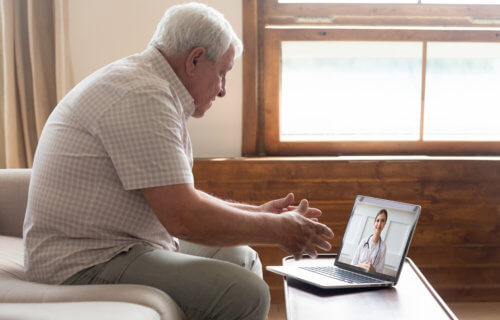SAN FRANCISCO, Calif. — COVID-19 is causing many things to move online, even our healthcare. Virtual doctor’s visits are useful for some patients, but what about the people who are regularly in need of aid? For older Americans, managing video screens and solving complex problems with their devices can put healthcare out of reach. Despite the rise of telehealth technology, a new study finds 13 million seniors in the United States may be struggling to connect with their doctors during the pandemic.
Researchers at the University of California, San Francisco say more than a third of adults over 65 face problems using telehealth services. The study finds the most at-risk patients include older seniors, low-income men, people in rural areas, and those with disabilities or in poor health.
“Telemedicine is not inherently accessible, and mandating its use leaves many older adults without access to their medical care,” says lead author Dr. Kenneth Lam in a university release. “We need further innovation in devices, services and policy to make sure older adults are not left behind during this migration.”
Telehealth challenges for seniors
The UCSF team says older adults make up a quarter of all U.S. medical office visits. These patients often suffer from multiple disabilities and health issues.
Although the U.S. Department of Health and Human Services and other medical officials are encouraging social distancing, relying on remote access isn’t that easy for seniors. The study looks at 2018 data from the National Health and Aging Trends Study of Medicare.
That information reveals poor hearing or eyesight, problems speaking, lack of internet-enabled devices, lack of awareness on how to use devices, no use of email or texting, and problems due to dementia are all among the many challenges older Americans face.
Researchers studied over 4,500 Medicare beneficiaries older than 65. The average patient was just under 80 years-old. Based on the results, the study estimates 38 percent of all U.S. seniors (13 million people) are not prepared to handle telehealth visits. That number soars to 72 percent for Americans over the age of 85. The biggest issues are caused by an inexperience with technology and physical disabilities.
Third-party help does little to solve the problem
The authors say even when another person is there to support older patients get connected, 32 percent still are unprepared to use telemedicine. That’s around 10.8 million people. Another 20 percent of the study could not even handle a telephone call due to dementia or communication issues.
Lam says the U.S. healthcare system has to develop easier methods for disabled seniors to reach their doctor during the pandemic. For medical offices with several elderly patients, closing in-person services may not be an option.
“We need actionable plans and contingencies to overcome the high prevalence of inexperience with technology and disability in the older population,” adds Lam, who is a clinical fellow in geriatrics at UCSF. “This includes devices with better designed user interfaces to get connected, digital accommodations for hearing and visual impairments, services to train older adults in the use of devices and, for some clinicians, keeping their offices open during the pandemic.”
The study appears in JAMA Internal Medicine.
